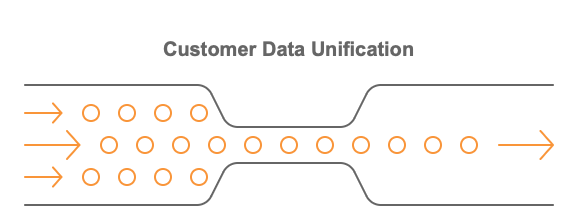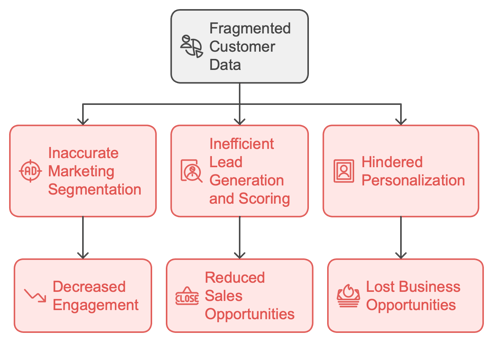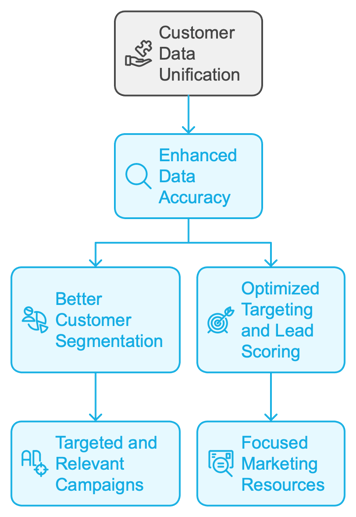What is Customer Data Unification?
Customer data unification is the process of integrating these disparate data sources into a single, cohesive profile for each customer. In today's data-driven business environment, customer data is gathered from an increasing number of touch points—websites, social media platforms, customer service interactions, emails, and more. This wealth of information, while valuable, often exists in fragmented silos across various departments and systems.
In the following sections, we will explore the key areas where customer data unification plays a pivotal role and how fragmented customer data can cause issues.
Challenges of Fragmented Customer Data
Common Problems Due to Scattered Data
When customer data is scattered across multiple, disconnected systems, businesses face numerous challenges. These fragmented data silos can result in:
-
Duplicate Records: Without a centralized system, the same customer may exist in multiple databases, leading to duplicate records. This creates confusion and makes it difficult for teams to maintain an accurate view of each customer.
-
Incomplete Data: Vital information about customer behavior or history may reside in different systems (e.g., marketing platforms, CRM, sales tools), leaving businesses with an incomplete understanding of their customers. Missing pieces of information can lead to poor decision-making and missed opportunities.
-
Disjointed Customer Profiles: With data spread across various platforms, companies often struggle to create a cohesive and accurate customer profile. This disjointed view makes it difficult to identify customer needs and preferences, leading to ineffective engagement strategies.

Negative Impact on Marketing and Sales Efficiency
Fragmented customer data has a direct impact on the efficiency and effectiveness of marketing and sales efforts:
-
Inaccurate Marketing Segmentation: Siloed data leads to poor segmentation because marketing teams lack a holistic view of customer behavior. Without accurate data, campaigns become less targeted, decreasing engagement and ROI.
-
Inefficient Lead Generation and Scoring: Sales teams rely on complete and accurate data to properly score and prioritize leads. Fragmentation results in missed signals, leading to ineffective lead generation and reduced sales opportunities.
-
Hindered Personalization: Personalization is critical in today’s competitive market, but fragmented data makes it difficult to deliver personalized experiences. Without a unified customer view, businesses can’t tailor their messaging, offers, or interactions to meet individual customer needs, ultimately leading to disengagement and lost opportunities.

Benefits of a Unified Customer Data Platform (CDP)
360-Degree Customer View / Impact on Sales and Marketing
One of the greatest advantages of unifying customer data through a platform like a Customer Data Platform is the ability to create a 360-degree view of each customer. This comprehensive profile captures every interaction a customer has with the company—across all channels and touchpoints.
With this complete view, businesses can:
- Deliver Personalized Marketing: Understanding customer behavior at every stage of the journey allows companies to tailor their marketing messages specifically to individual preferences and needs.
- Improve Decision-Making: Access to complete and accurate data empowers decision-makers to derive actionable insights, enabling smarter strategies for customer engagement, retention, and acquisition.
Enhanced Data Accuracy for Better Segmentation and Targeting
Data unification improves the accuracy and reliability of customer information, which has a direct impact on marketing and sales activities:
-
Better Customer Segmentation: With a unified data platform, marketers can segment customers based on accurate, real-time information, leading to more targeted and relevant campaigns.
-
Optimized Targeting and Lead Scoring: When customer data is complete and consistent, sales teams can more effectively score and target leads based on behavior, demographics, and engagement history. This ensures that marketing resources are focused on high-potential prospects, leading to higher conversion rates and more efficient lead nurturing.

Implementing Customer Data Unification: Step-by-Step Guide
Step 1: Identify and Integrate Data Sources
-
List existing data sources: Start by identifying all systems where customer data resides (CRM, email marketing, ecommerce platforms, social media, etc.).
-
Use HubSpot's native integrations: Leverage HubSpot's integrations to pull data from various sources like Salesforce, Shopify, Google Ads, and social media platforms.
-
Utilize APIs or third-party tools: For platforms without native integrations, use HubSpot’s Operations Hub or third-party integration tools (like Zapier) to sync the data. This ensures all customer data flows into one centralized HubSpot CRM database.
Step 2: Cleanse and Standardize Data
-
De-duplicate customer data: Use HubSpot’s data management tools to find and merge duplicate records. HubSpot’s deduplication feature allows you to clean up and standardize customer profiles.
-
Standardize formats: Ensure all data fields (e.g., phone numbers, addresses, names) follow consistent formatting across records to avoid mismatches and inaccuracies.
Step 3: Map Data for Unified Profiles
-
Create custom properties: Define specific data fields in HubSpot for unique attributes from external systems. Map these fields accordingly when integrating the data.
-
Firmographic and demographic data: If applicable, enrich your customer profiles with firmographic data(such as industry, company size) using third-party data providers.
Step 4: Use HubSpot Workflows for Automation
-
Automate data sync: Set up workflows in HubSpot to regularly sync and update customer profiles with new data from integrated sources.
-
Automated data enrichment: Use HubSpot's workflows to auto-populate missing information in customer profiles, based on available data across different sources.
Step 5: Segment Customer Profiles
-
Create smart lists: Use HubSpot’s smart lists to automatically segment customers based on consolidated data. You can filter based on behavior, demographics, or other attributes to create dynamic customer groups.
-
Use firmographic segmentation: Leverage firmographic data to create targeted marketing campaigns by segmenting B2B customers according to industry, company size, and location.
Step 6: Set Up Reporting and Insights
-
Custom reports: Build custom reports in HubSpot’s reporting dashboard to track customer engagement and segment performance based on consolidated data.
-
Track conversion metrics: Monitor conversion marketing metrics such as engagement rates, and identify customer touchpoints that drive conversions.
FAQ: Customer Data Unification
1. What is customer data unification?
Customer data unification is the process of integrating customer data from various sources (like CRM, social media, emails, and websites) into a single, cohesive profile for each customer. This unified profile helps businesses create a complete view of customer behavior and interactions across all touchpoints.
2. Why is fragmented customer data a problem?
Fragmented customer data creates challenges such as duplicate records, incomplete data, and disjointed customer profiles. This makes it difficult for businesses to gain a full understanding of their customers, leading to poor decision-making and ineffective marketing and sales efforts.
3. How does unified data improve marketing and sales efficiency?
With a unified customer data platform (CDP), marketing teams can improve segmentation and targeting, leading to more personalized campaigns. Sales teams can better score and prioritize leads, ultimately increasing conversion rates and driving more effective customer engagement.
4. What are the main benefits of using a Customer Data Platform (CDP)?
A CDP provides a 360-degree view of each customer, allowing businesses to deliver personalized marketing, improve decision-making, and enhance data accuracy for better segmentation and targeting. This leads to more relevant customer interactions and higher ROI on marketing and sales efforts.
5. How can businesses implement customer data unification?
The process involves identifying and integrating data sources, cleansing and standardizing data, mapping data for unified profiles, automating data sync and enrichment, segmenting customer profiles, and setting up reporting tools to gain insights and track performance.